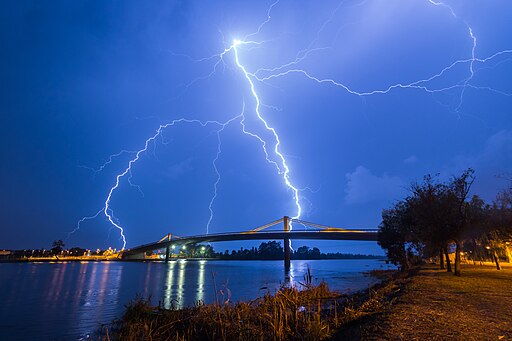 How to Stay Safe in a Lightning Storm
How to Stay Safe in a Lightning Storm
From Clatsop County, OR Emergency Management
Thunderstorms can be dangerous. Every thunderstorm produces lightning. In the United States, an average of 300 people are injured and 80 people are killed each year by lightning. Although most lightning victims survive, people struck by lightning often report a variety of long-term, debilitating symptoms.
Other associated dangers of thunderstorms include tornadoes, strong winds, hail, and flash flooding. Flash flooding is responsible for more fatalities—more than 140 annually—than any other thunderstorm-associated hazard.
Dry thunderstorms that do not produce rain that reaches the ground are most prevalent in the western United States. Falling raindrops evaporate, but lightning can still reach the ground and can start wildfires.
Facts about thunderstorms
- They may occur singly, in clusters, or in lines.
- Some of the most severe occur when a single thunderstorm affects one location for an extended time.
- Thunderstorms typically produce heavy rain for a brief period, anywhere from 30 minutes to an hour.
- Warm, humid conditions are highly favorable for thunderstorm development.
- About 10 percent of thunderstorms are classified as severe—one that produces hail at least three-quarters of an inch in diameter, has winds of 58 miles per hour or higher, or produces a tornado.
Facts about lightning
- Lightning’s unpredictability increases the risk to individuals and property.
- Lightning often strikes outside of heavy rain and may occur as far as 10 miles away from any rainfall.
- “Heat lightning” is actually lightning from a thunderstorm too far away for thunder to be heard. However, the storm may be moving in your direction!
- Most lightning deaths and injuries occur when people are caught outdoors in the summer months during the afternoon and evening.
- Your chances of being struck by lightning are estimated to be 1 in 600,000, but could be reduced even further by following safety precautions.
- Lightning strike victims carry no electrical charge and should be attended to immediately.
Familiarize yourself with these terms to help identify a thunderstorm hazard:
Severe Thunderstorm Watch – Tells you when and where severe thunderstorms are likely to occur. Watch the sky and stay tuned to NOAA Weather Radio, commercial radio, or television for information.
Severe Thunderstorm Warning – Issued when severe weather has been reported by spotters or indicated by radar. Warnings indicate imminent danger to life and property to those in the path of the storm.
To prepare for a thunderstorm, you should do the following
- Remove dead or rotting trees and branches that could fall and cause injury or damage during a severe thunderstorm.
- Remember the 30/30 lightning safety rule: Go indoors if, after seeing lightning, you cannot count to 30 before hearing thunder. Stay indoors for 30 minutes after hearing the last clap of thunder.
The following are guidelines for what you should do if a thunderstorm is likely in your area
- Postpone outdoor activities.
- Get inside a home, building, or hard top automobile (not a convertible). Although you may be injured if lightning strikes your car, you are much safer inside a vehicle than outside.
- Remember, rubber-soled shoes and rubber tires provide NO protection from lightning. However, the steel frame of a hard-topped vehicle provides increased protection if you are not touching metal.
- Secure outdoor objects that could blow away or cause damage.
- Shutter windows and secure outside doors. If shutters are not available, close window blinds, shades, or curtains.
- Avoid showering or bathing. Plumbing and bathroom fixtures can conduct electricity.
- Use a corded telephone only for emergencies. Cordless and cellular telephones are safe to use.
- Unplug appliances and other electrical items such as computers and turn off air conditioners. Power surges from lightning can cause serious damage.
- Use your battery-operated NOAA Weather Radio for updates from local officials.
Avoid the following
- Natural lightning rods such as a tall, isolated tree in an open area
- Hilltops, open fields, the beach, or a boat on the water
- Isolated sheds or other small structures in open areas
- Anything metal—tractors, farm equipment, motorcycles, golf carts, golf clubs, and bicycles
During a Thunderstorm
If you are: Then:
| In a forest | Seek shelter in a low area under a thick growth of trees |
| In an open area | Go to a low place such as a ravine or valley. Be alert for flash floods |
| On open water | Get to land and find shelter immediately |
| Anywhere you feel your hair stand on end (which indicates that lightning is about to strike) | Squat low to the ground on the balls of your feet. Place you hands over your ears and your head. Make yourself the smallest target possible and minimize your contact with the ground. DO NOT lie flat on the ground. |
The following are things you should check when you attempt to give aid to a victim of lightning:
- Breathing - if breathing has stopped, begin mouth-to-mouth resuscitation.
- Heartbeat - if the heart has stopped, administer CPR.
- Pulse - if the victim has a pulse and is breathing, look for other possible injuries. Check for burns where the lightning entered and left the body. Also be alert for nervous system damage, broken bones, and loss of hearing and eyesight.






